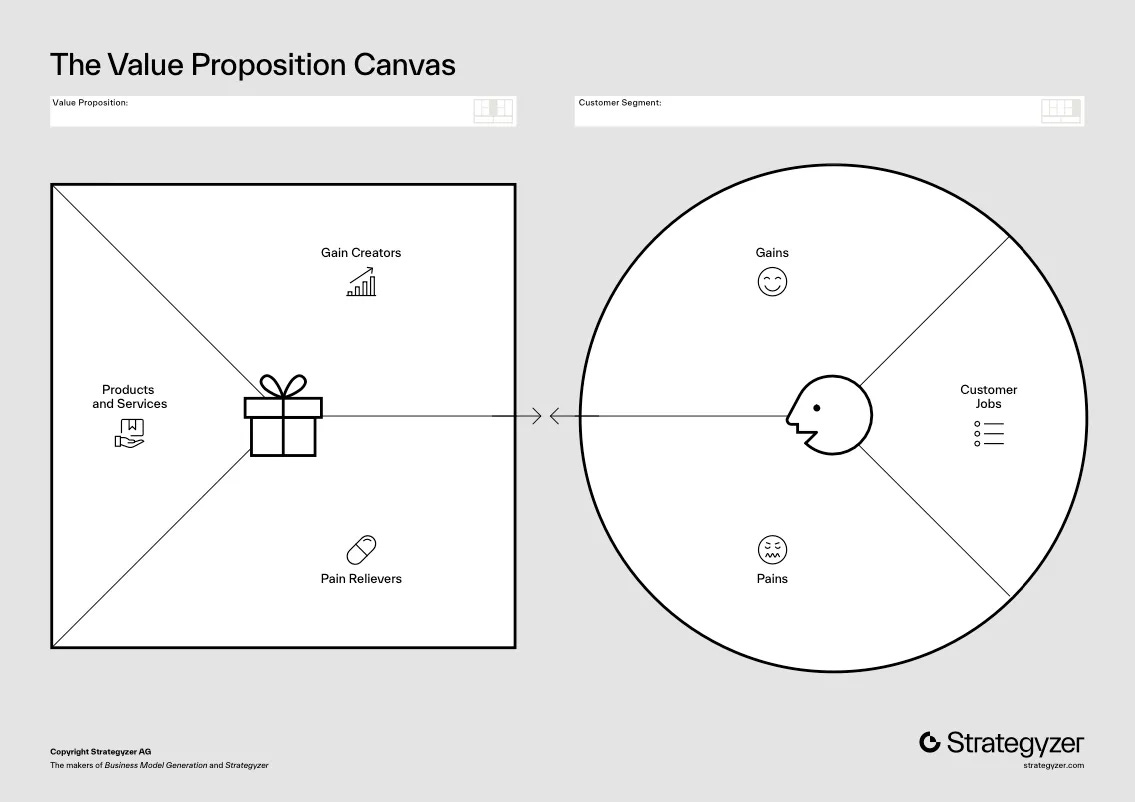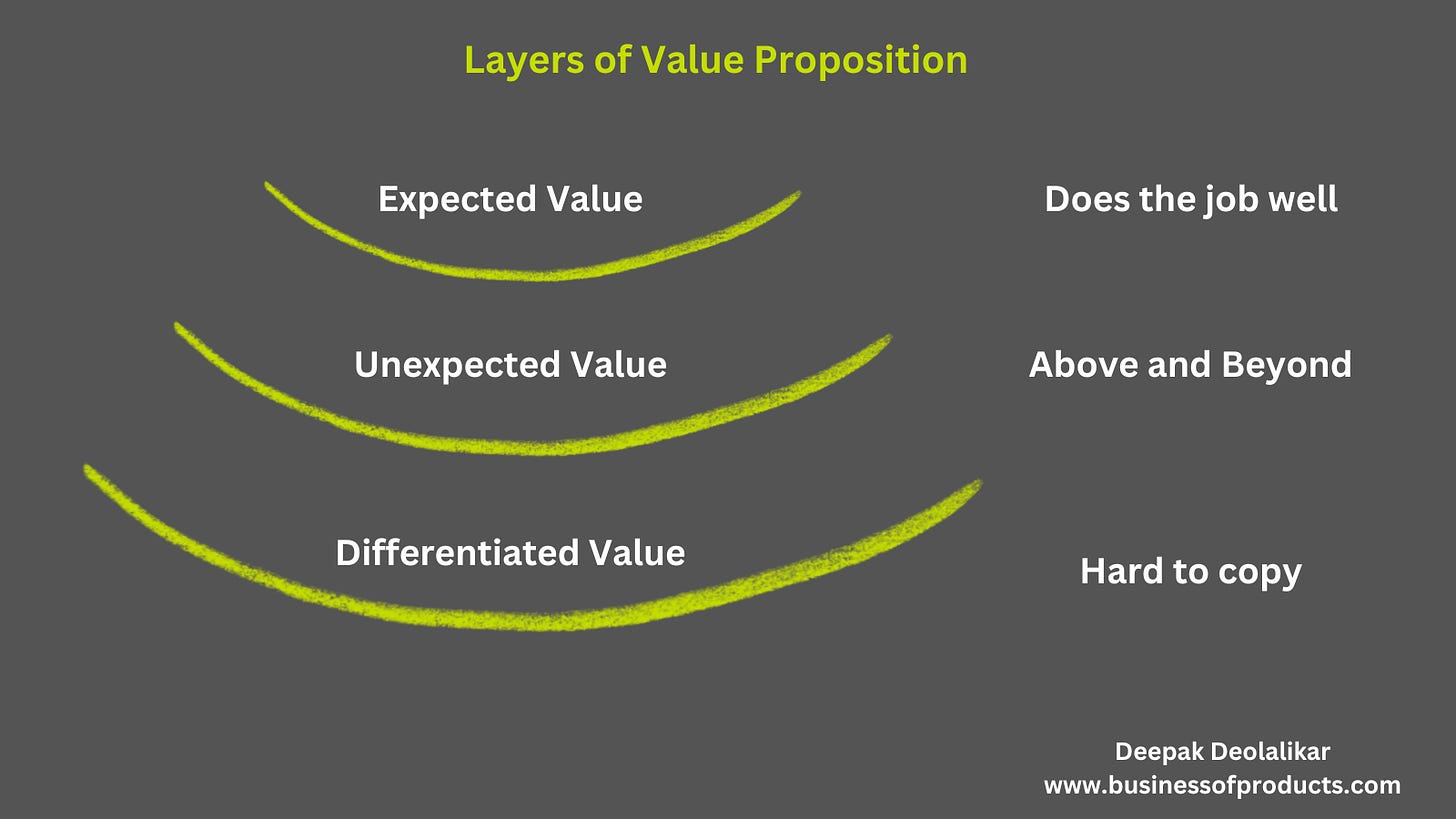Value proposition design for your B2B product
At a superficial level, value proposition means building something that creates value for your customers. It’s a good starting point but not sufficient to explain it, and more importantly, not sufficient to design a product you can sell.
Many startups and product managers use superficial terms to explain the value proposition of their products.
Easy
Seamless
Beautiful
Streamlined
These are merely buzzwords and not defendable or measurable. Anyone can claim their product is easy or seamless.
You have to dig deeper to determine the true value proposition.
Value Proposition Canvas
I was teaching value proposition design in one of the Lean Entrepreneurship sessions. The framework we use is the Value Proposition Canvas, which was created by Alex Osterwalder. The same person who created the Business Model Canvas.
The VPC is a useful canvas to determine how you are going to provide value.
It has two sections.
Customer Segments
Value Proposition

The right side of the canvas is your customer context.
What are the jobs to be done? functional, social, emotional.
What are the desired gains in an ideal situation?
What are the existing pain points of customers who are trying to do that job?
The left side of the canvas is your product.
What capabilities are you going to provide that does the jobs to be done on the right hand side?
What are the gain creators in your product?
How are you removing or reducing the pain based on the pain points of customers?
All you have to do now is to learn from your target segment what their gains and pains are. And then build a product that maps to the pains and gains and does the jobs to be done.
So in theory you now have a product that meets the expectations of the customer.
Is that enough? Will this sell?
Not yet. there is a more nuance way of defining your value proposition.
Layers of Value Proposition
I break down value proposition into 3 parts.
Expected Value
Unexpected Value
Differentiated Value

Expected Value
Based on your discovery and validation, you have already determined the desires and needs of your customer segment. This is documented in the value proposition canvas. Your product or services does the jobs to be done in an effective manner and takes into account the desired gains and address the user pain points.
Now you might expect, our work as a product is done. Not quite.
You will also have to make sure that you deliver the value effectively with least friction. That means taking care of onboarding, ongoing engagement with customers, documentation, support etc.
Let’s say you build a product that meets the expectations of the customer but the onboarding is not a good experience or support is not able to respond in a timely manner. That value is now deemed lesser than expectation, even if the product itself is working fine.
So as a PM, ensuring you build the right product that provides the right value is a necessary starting step but not sufficient. You need to ensure that the customer actually gets the value and build your processes/documentations accordingly.
At this stage, your product meets the exceptions of the customer. Is that enough?
Unexpected Value
The real delight comes when you add unexpected value. This is something the customer did not expect.
In 2020, I bought the Tesla Model 3. It met my expectations of the jobs to be done. Great driving experience and nice bells and whistles.
But they also added extra value. For example, they gave free supercharging and premium connectivity for a year. This was unexpected and added to my perceived value.
Now, granted this was a marketing gimmick to increase sales, but an important consideration for someone on the fence about the decision.
But unexpected value need not just be a marketing gimmick or a short term value.
For example, you can offer a free 5 year warranty on your product and a free replacement within that period. This is something a customer would not have expected.
Unexpected value can come in many different shapes and forms.
Capabilities – Adding capabilities above and beyond the expected can create the feeling of getting more for your investment. For example, a banking application can include automated bill payment that pays the monthly bills automatically so you don’t have to think about it. Think about areas that are of value that you may not have heard from your customer but they provide the additional value. As a PM, it is your job to dig deeper and figure out the additional value points.
Services – If your product is complex, you may want to offer impeccable service such as migration, onboarding, training etc. The customer will value these add ons.
Pricing – you can offer your product at a much lower price point or create bundles that allow customers to choose what they specifically want and lower their total cost of ownership. For example, if your competition is charing extra for storage or API access, then you can bundle them in your price for unlimited access. That’s an opportunity to provide unexpected value.
Network – Creating a network effect also adds a lot of value that a customer might not have expected. Think of Canva and their army of free lance designers who create the templates that customers can use. Without that, many customers would drop off as they would not be able to use Canva effectively. The tool itself is great to get started with your design, but the unexpected value is the ability to start from a set of pre designed templates so you don’t have to think. Your time to value is drastically shortened.
Community – Having a community of like minded users is a great value to customers. This is especially true for complex B2B applications where there are many best practices. At SugarCRM, we had a community of users who would talk to each other and solve their problems mutually and collaboratively. As a product person, you may not know everything about the various use cases of your customers but other similar customers would know. And if you connect them, that’s an additional value.
Data – Your product provides additional data points that helps the customer with their jobs to be done more effectively. Say a financial accounting application that only keeps the books well and creates nice dashboards (expected value) but compares your spending habits with other people in your segment, so that you can benchmark yourself.
Effort – Your product not only provides the value customer expected but it does so with minimal effort from user. Imagine a CRM that can update all the values after a sales rep ends a customer meeting, by using the call recording and converting that into data for the CRM.
Differentiated Value
Now you have a product meets the expectations of the customer and also adds some unexpected value. That should delight customers. However, you do not live alone in the marketplace.
You have competitors and alternatives. And guess what, they are also thinking about the same expected and unexpected value streams.
You have to find something unique in your product or service that is difficult to copy for a competitor.
Ways to Differentiate Your B2B Product
In the competitive B2B landscape, differentiation is key to standing out and attracting customers. Here are some strategies to help your product stand apart:
Superior Functionality and Performance: Your product solves the customer pain points in a superior way as demonstrated by time and effort take by the customer. You have features that work better than your competitor.
Exceptional Customer Experience: In B2B, provided a good customer experience is essential, starting the right boarding.
Niche Focus: Your product is neatly fitted for a segment with underserved needs. While there may be competitors, your product is best suited for the job.
Strong Brand Identity: Having a strong brand creates the necessary trust in your customer relationships.
Innovative Technology: Your ability to innovate and bring compelling solutions to market also helps you differentiate.
Partnerships and Integrations: Integrating with partners helps you build a whole solution that your customers will value. Having all the right integrates for your customer segment also helps you to differentiate. Integrations with other systems is an important consideration for customers.
Social Proof and Testimonials: Feedback from customers is a source of advantage for you. The feedbacks acts a signal to the market that customers like your product so much that they are willing to talk about it.
Conclusion
We live in a competitive world. Building a product that meets the expectation of the customer is not enough.
You have to dig deeper to find sources of unexpected value and differentiate value.
That will make a compelling product and become the best or the only option for your prospects in your target segment.

